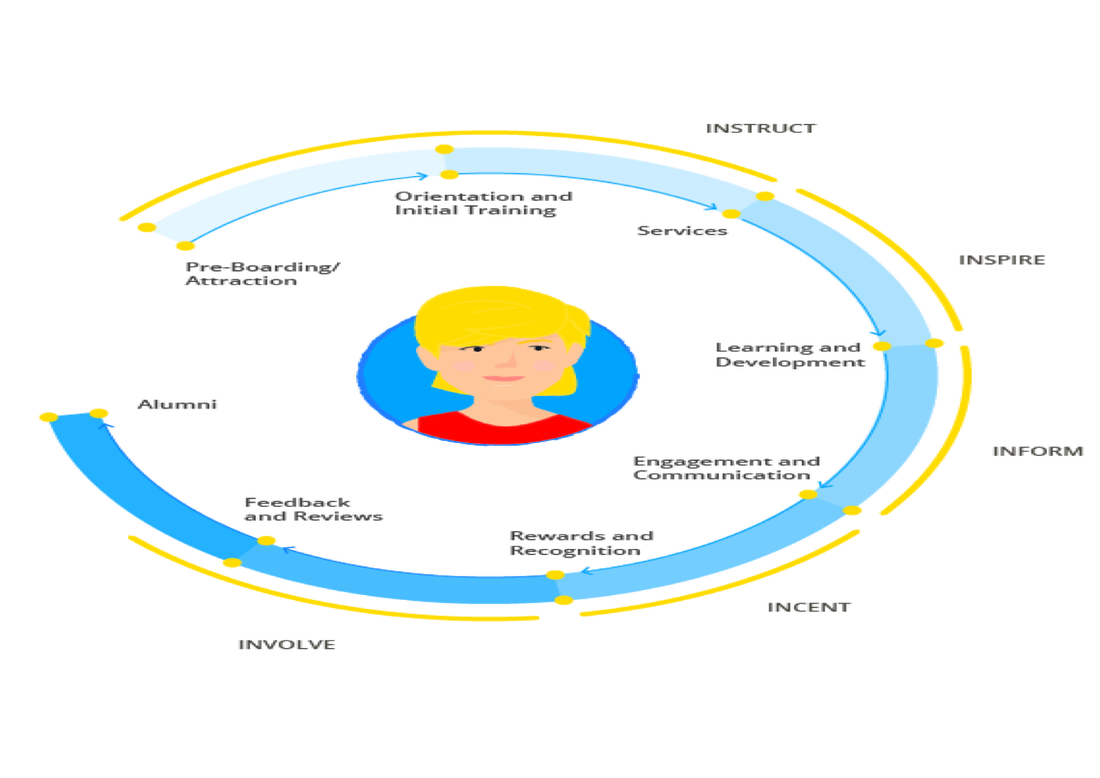|
Employee experience (EX) is as equally critical and significant as is Customer Experience (CX). There has been a rise of a new prolific, affirmative employee experience as a silent mode of undertaking from the employer towards his employee which has taken a validated stand. Companies have come to realize that in order to build successful customer experience, they need to prioritize and keep their employee's needs much before their customers. Businesses that are active in putting forth employee concerns first have been regularly observing that it by default leads to better consistent customer service. Employee experience is augmented as an interactive exposure across the following spheres: the physical, cultural and technological environments surrounding the employees, their social connections, their collective perceptions across time and touchpoints and the aspect of work. An ideally crafted EX will reflect a company’s unique brand characteristics. Whenever an organization builds an engaged and empowered workforce it depicts their intentional approach to designing its employee experience. It denotes that the organization is serious and dedicated about employee welfare. Figure 1: Employee Experience CycleThese statistics below will reveal the impact of engaged employees on overall productivity:
5 strategies deployed by companies to improve their overall employee experience. Personalization of activities:It is human nature that anything which is accustomed to a particular character in nature breeds better results than a mass activity. For example, if an employee is provided specially modulated training tailored towards their specific learning objectives, performance, and career goals, they feel elated and are more confident towards their work. Transparency of conduct,Communication is always a two-way channel. Just as employees are expected to report on their day-to-day work output, similarly higher authorities are expected to be prompt in providing guidance, transparent in dealings, detailing the project scope, and support the employee in every which way possible right till the end. This transparency, in turn, cultivates the environment of trust which impacts the ‘sense of belonging’ and harnesses productivity levels of employees. Simplification of procedures:The simpler the procedures, the easier it is for the employee to follow instructions. The easier the execution, the speedier the output. Like is the norm in organization development, if it cannot be explained in simplified terms then one has not understood it enough. On the other hand, simplification efforts such as removal of chunks which add no value to the entire system, easy access to knowledge pools or changing the way information is displayed or shared – all these steps can create a more positive work environment. The authenticity of action:This develops credibility in the long term. The organization “mission” should percolate at each and every touchpoint and the employee should ‘live and breathe’ the organizational dream. The values should reflect in every aspect of the business right from branding to interiors, choice of business partners to public events, etc. Organizational responsiveness.Feedback is a constant loop. What goes around should come around. Company culture should be adaptable to change as per the latest trends and recommendations for the better. Companies are now getting in the gear to integrate responsiveness into their ongoing performance management systems. Feedback needs to be captured on an ongoing basis to fine-tune the original solution and make appropriate shifts in strategy and approach. This also minimizes the risk management process. Popular methods for enhancing employee experience: To leverage real-time data & analytics, identify need gaps and measure their impact on business outcomes. Organizations use analytics to develop insights about specific segments of the population. These can also be used to identify shifts in physical and social environments. Analytics can also inflate the weight of employee voice and can be used to address concerns associated with productivity and usage of tools. To identify and invest in differentiation touchpoints, which means a diagnosis of turning points in the employee life cycle which makes or can make a difference and drive entire attention there. For example, in some companies, when employees are assigned challenging projects and tasks which are career development-oriented make a noteworthy impact on retention and productivity. In these cases, task management software and project management software can play a critical role. To caste a cross-functional experience alignment: A company that intends to design an integrated experience around the physical, social and task spheres needs to get hold of a multi-functional perspective. To truly recognize employee efforts, the company has to understand key junctures in the employee work journey so as to refine insights where they may lack experience and decide upon corrective measures that can be most effective. Apply brisk, repetitive routine wise design principles– These devices or principles need to be agile so as to enhance employee experience. The application of a wholesome, repetitive design approach to change, helps ensure that employees witness work improvements that are of relevance. Thus accordingly their expectations are set for continuous reinvention. The employer has to be alert, observant, keep an ear out, and learn how employees are working day-in-day-out and discover new ways to make the work seem simpler and at the same time improve productivity. It would be a great idea to develop employee personas and use them to create relevant journey maps to create excitement and the ‘fun’ factor. Each stage of the employee journey and work cycle needs to be checked upon, so as to locate the physical, social and work-related interactions that take place at each stage. At the same time work on remedies for addressing limitations or obstacles. The solutions need to be developed at a rapid pace that can solve portions of the puzzle over short periods of time rather than creating one larger solution that may take an elongated time period to execute and put into action. This saves on valuable time and efforts which can be better utilized. The definite task of employee experience cannot be made the responsibility of a specific supporting function; rather, it needs to be woven into the very caricature of your business. Senior leadership management plays a crucial role in laying the foundation of many such opportunities and ultimately ensuring a positively enthused and supportive work environment. Application of these principles to the design of employee experience can generate instant success scenarios enhance productivity and forbid large, emphatic costlier challenges in the future. Any project analysis was done post such activity will reveal and uphold the same. A company that can proudly carry off consistent affirmative employee experience then suggests that the particular company is amongst the top-rated and wanted job hunting playground. In all likelihood, it shall attract the talented lot, most engaged and productive staff that is available for hire. The Five Dimensions of Employee Experience Index:
How to drive a positive employee experienceCultivating a positive employee experience could well be a foremost reason and a contributory factor as has been shown to be associated with heightened individual worker performance & productivity, discretionary behavior, higher customer satisfaction scores, higher levels of quality and lower absenteeism and attrition. A multiplying body of research keeps pointing to the benefits of a humanized workplace for creating positive employee experiences. According to research from IBM and Globoforce, a human workplace is primarily characterized by opportunities for: • Meaningful work • Empowerment and voice • Feedback, recognition, and growth • Cordial Co-worker relationships • Organizational trust • Work-life balance Employee Experience: The Gateway to the Future There is no doubt a connection between the significance of the employee experience in driving organizational efficiency and as an emerging source of sustained competitive advantage. With the radical revolution of work in the 21stCentury, one can safely reach to the conclusion that successful customer experiences begin and conclude with your own set of people. This validation is of extreme significance to industries across the board. Employees with a deep emotional connection to their respective companies are in a better position to inspire a favorable customer experience. A well-rounded strategy which is widely implemented with respect to EX, should take into account: Combined view of employee perceptions, environmental factors at the workplace, and a consumer-style approach to HR. Individuals these days expect the same type of experience at the workplace that they have the privilege of as consumers. Such a strategy is a sure shot success. It will for sure enough lead to greater levels of employee engagement, exuberance, participation, retention, and employer brand commitment. Once you’ve reached such a stage, prize yourself as experienced!
0 Comments
Your comment will be posted after it is approved.
Leave a Reply. |
Most useful blogs |
Hosted Applications |
Tax Hosting Services |
Accounting Applications |
ContactAddress
Cloudwalks Hosting, Inc. 40 Exchange Place, Suite 1602 New York, NY 10005 |



 RSS Feed
RSS Feed




